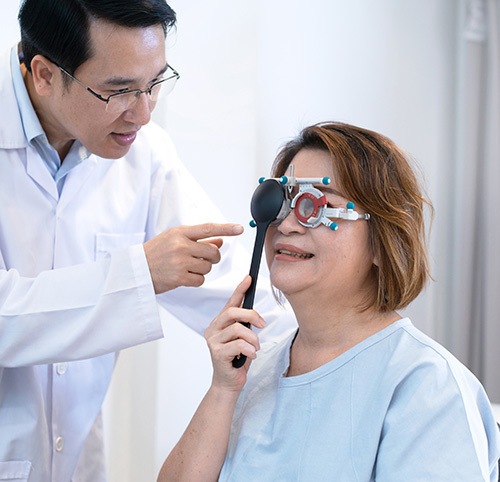
The Most Common Questions about Lazy Eye Symptoms, Causes, Diagnosis, and Treatment
Amblyopia, more commonly referred to as ‘lazy eye’, affects around 3% of children and is the most common condition to cause vision loss in adolescence. One common misconception about lazy eye syndrome is that it is merely a cosmetic concern that will eventually correct itself. Unfortunately, without proper treatment, amblyopia will only worsen over time and further reduce vision quality. In this guide, we answer the most common questions about lazy eye, its causes, how it’s diagnosed, and the best treatment options for amblyopia in children and adults.
1. What Causes Lazy Eye?
One of the most common questions about lazy eye is what causes it. Lazy eye occurs when one eye does not work in coordination with the brain resulting in poor vision quality. This causes the brain to favor the other eye with better visual quality. Without treatment, the amblyopic or ‘lazy’ eye can wander, causing it to drift to either side, upward, or downward.
Refractive amblyopia on the other hand typically doesn’t cause the eye to wander, and even though one eye can see better than the other, they remain aligned symmetrically.
Lazy Eye vs Crossed Eyes
While amblyopia may cause one eye to wander and appear ‘lazy’, strabismus is a different condition that causes both eyes to point in different directions causing a ‘cross-eyed’ appearance. While one eye may sometimes point straight ahead, both eyes will never align in the same direction, and the misalignment can shift from eye to eye.
2. What Age Does Lazy Eye Occur?
Lazy eye generally develops in children between birth and the age of seven. When we are born, our eyes take time to adapt and learn how to properly focus light, movements, and colors. When a child has amblyopia, one eye is used far more efficiently than the other, which results in the weaker or ‘lazy’ eye developing poor vision quality.
A child may be more at risk for lazy eye syndrome if they:
- were born prematurely
- were born smaller than average
- have a family history of lazy eye syndrome or other eye conditions
- have developmental disabilities
Vision Conditions That Can Cause Lazy Eye
Injuries and diseases that affect the eye or optic nerve can lead to lazy eye as well. Some of these conditions include:
- Refractive errors (nearsightedness, farsightedness, or astigmatism)
- Scars on the cornea
- Retina diseases
- Optic nerve damage (Cause by conditions such as Glaucoma)
- Cataracts
- Ptosis (drooping of the upper eyelid)
3. What are the Symptoms of Lazy Eye?
Some of the most common symptoms and signs of amblyopia include:
- Misalignment of one eye
- Difficulty determining how close or far away an object is (depth perception)
- Rubbing eyes frequently
- Low eye-hand coordination
- Turning the head to look at an object directly in front of them
- Poor ability to follow an object with just the eyes (not moving the head)
- Squinting or shutting one eye
- Persistent head tilting
- Persistent head shaking
- Frequent eye flickering or blinking
Unless a child has an obvious misalignment in their eyes or clearly favors one eye over the other, it can be difficult for parents to know something is wrong. Many children may not even realize they can see better out of one eye compared to the other.
4. How is Lazy Eye Diagnosed?
The only way to diagnose amblyopia is through comprehensive vision testing performed by an ophthalmologist. Through a variety of non-invasive tests, your eye doctor will be able to detect any differences in visual quality between the eyes.
For young children, getting a precise measurement of their vision can be challenging. So your ophthalmologist will cover one eye at a time and watch how well the child follows objects with each eye to get an estimate of their visual acuity.
These tests are not painful, but if a child does have an amblyopic eye they may cry or become distressed when their stronger eye is covered. Suddenly not being able to see clearly would be distressing for anyone.
If your ophthalmologist determines that your child has poor vision in one eye, they will then move on to a more comprehensive examination to look for any signs of other ocular disorders or diseases of the inner eye.
5. How Is Lazy Eye Treated?
Another of the most common questions about lazy eye is treatment options. If your child has been diagnosed with amblyopia, it is essential to begin treatment as soon as possible. Depending on the advisement of your ophthalmologist, there are a number of different treatment options for lazy eye including:
Corrective Eyeglasses – If a child develops a lazy eye due to a refractive error such as nearsightedness, farsightedness, or astigmatism, the problem can often be corrected with eyeglasses.
However, it is important to note that while eyeglasses may help treat a lazy eye caused by a refractive error, the underlying vision condition will remain and they will need to continue to wear corrective eyewear to see clearly.
Eye Patches (Eye Training) – Wearing an eye patch over the dominant eye for periods of time forces their brain to use the weaker one. This helps strengthen the connection between the brain and the amblyopic eye, improving its visual quality over time.
While the child wears the patch over the stronger eye, they may be instructed to play certain games or do certain activities specifically designed to help strengthen and train the eye.
Eye Drops – Your ophthalmologist may prescribe eye drops containing a medication called atropine which blurs the vision in the stronger eye. While vision in the dominant eye is temporarily reduced, the brain is forced to rely on the amblyopic eye, strengthening its ability to function correctly over time.
Bangerter Filters – Not every child can tolerate wearing eyepatches for several hours a day. In some cases, these children can opt for Bangerter filters. These filters are an opaque covering that fits on the inside of the glasses lens covering the stronger eye.
Bangerter filters must be worn full-time. However, the density and opaqueness of the filter can be adjusted over time as the condition improves.
6. Can Adults be Treated for Lazy Eye?

Lazy eye treatment is most effective on younger children and should be administered as soon as a child has been diagnosed with amblyopia. However, treating a lazy eye in adults is still very much a possibility.
While every patient will be unique, adults with a lazy eye may require longer treatment periods than a child would, but many of the same therapies are just as effective.
7. How Long Does it Take to Treat Lazy Eye?
Depending on the severity, treatment can last anywhere from a couple of months to two years. With proper treatment, most patients will begin to see vision improvements within a few weeks to months.
It’s important to continue to follow all treatment instructions provided by your doctor, even with positive improvements in vision quality.
8. Can Lazy Eye Come Back?
Unfortunately, 25% of people who have amblyopia at a young age, develop the condition again later on in life. This makes it incredibly important for anyone who has ever been diagnosed with an eye condition to attend routine eyes exams to ensure optimal vision health
9. Can Surgery Fix Lazy Eye?
Currently, there is no surgical option for treating lazy eye. The idea of a ‘lazy eye surgery’ is a common misconception that usually comes from the confusion between strabismus (crossed-eyes) and amblyopia (lazy eye). Strabismus surgery involves repositioning the eye muscles to help the eyes point in the same direction.
However, in cases where a cataract causes a patient to develop a lazy eye, surgery to remove the clouded lens can result in amblyopia being corrected as well.
Find the Best Amblyopia Treatment Options at NeoVision Eye Center
If you believe your child may be experiencing lazy eye symptoms, or that you may have amblyopia yourself, the ophthalmologists at NeoVision Eye Center are here to help. With early diagnosis and proactive treatment, correcting a lazy eye and improving vision quality can be simple. The most effective way to ensure your vision and eye health is to begin having comprehensive eye exams at a young age.
The board-certified ophthalmologists at NeoVision Eye Center have years of experience successfully diagnosing and treating amblyopia in children and adults. If you suspect that you or your child may have amblyopia, contact our team today to schedule a consultation.






